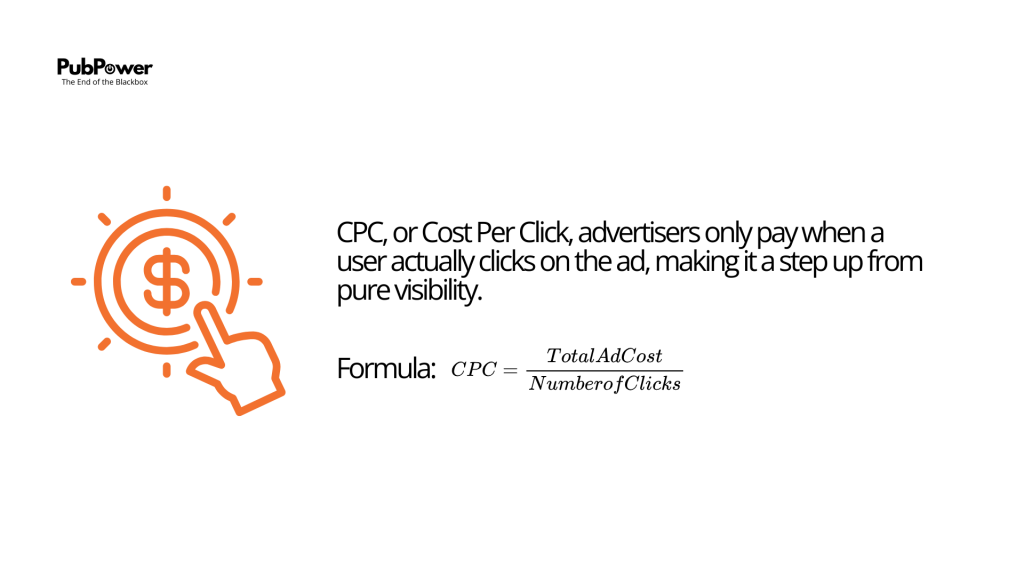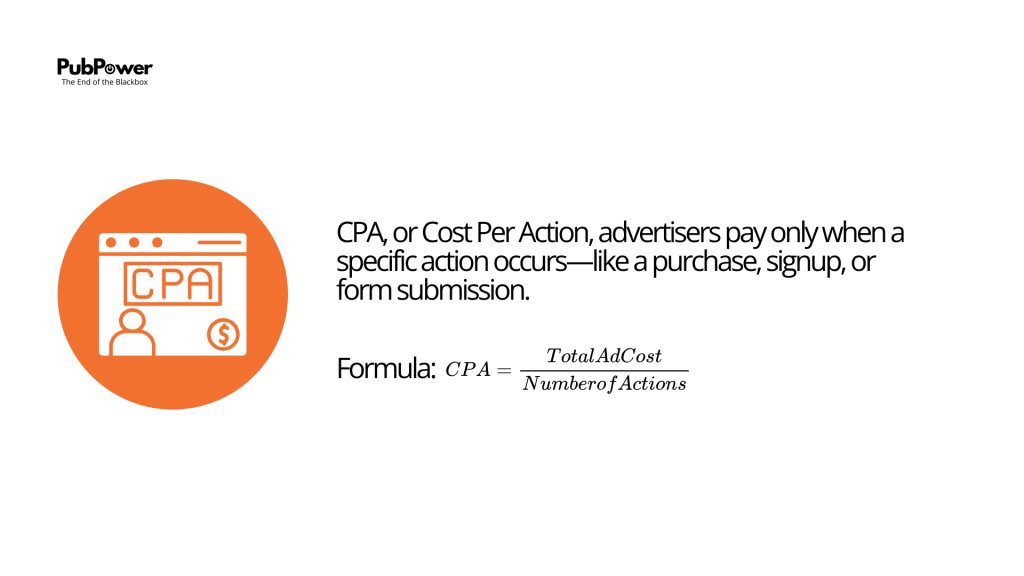In the fast-paced world of digital advertising, picking the right pricing model can make or break your revenue strategy as a publisher. We’ve spent over a decade navigating these waters, helping brands and publishers like you optimize their ad setups for real results. Whether you’re running a niche blog, a high-traffic news site, or an app with engaged users, understanding CPM, CPC, and CPA isn’t just about jargon—it’s about unlocking more control and earnings from your inventory. These models dictate how advertisers pay and how you get compensated, directly impacting your bottom line. We’ll break them down step by step, drawing from current industry insights, so you can see what fits your setup. Let’s dive in with clear explanations, practical examples, and tips to boost your performance.
Contents
What is CPM?
Last blog, we mentioned CPM; however, we will still explain it in a careful way in this blog.
CPM, or Cost Per Mille (Latin for “thousand”), is all about paying for visibility. It’s the amount an advertiser pays for every 1,000 times their ad appears on your site or app—known as impressions. An impression counts each time the ad loads and is viewable, even if the user doesn’t interact with it.
This model shines for broad exposure, making it a go-to for awareness campaigns. As a publisher, you earn based on how many eyes see the ad, which is great if your site draws steady traffic without needing clicks or sales.

CPM Formula and Example
The basic formula for CPM is:
CPM = (Total Campaign Cost ÷ Total Impressions) × 1,000
For instance, if an advertiser spends $500 on a campaign that generates 100,000 impressions, the CPM is ($500 / 100,000) × 1,000 = $5. That means they’re paying $5 per 1,000 views. On your end as a publisher, if you’re earning from these impressions, a higher CPM directly boosts your payout—think premium content sites where ads command $1–$25 per 1,000 impressions, depending on the niche like finance or tech.
When to Use CPM
CPM works best when your goal is reach over immediate action. It’s ideal for:
- High-traffic sites or apps where impressions pile up quickly, like news portals or entertainment hubs.
- Premium or niche content with strong engagement, such as video platforms using in-stream ads.
- Formats like display banners, interstitials, or rewarded ads that ensure high viewability.
- Brand awareness pushes, like product launches or seasonal promotions.
In my experience, publishers with consistent daily visitors (say, over 10,000) see steady revenue here, as you’re paid regardless of user clicks. Pair it with tools for better targeting to avoid low-quality impressions.
Pros and Cons of CPM
Here’s a balanced look:
Pros:
- Predictable income: You get paid for every impression served, creating a reliable stream even on slower engagement days.
- Great for scale: High-traffic sites can turn modest rates into big earnings—global digital ad spend hits $740 billion in 2025, with CPM fueling much of the awareness slice.
- Boosts brand visibility: Advertisers love it for exposing ads to large audiences without needing interactions.
Cons:
- No guarantee of engagement: Revenue doesn’t tie to clicks or conversions, so low-interest ads might underperform.
- Vulnerable to ad blockers: These can slash impressions by 10-20%, hitting your earnings hard.
- Quality vs. quantity pressure: You might prioritize more ads over user experience, risking site bounce rates.
Overall, CPM is low-risk for publishers but demands strong traffic to shine.
What is CPC?
Shifting gears, CPC stands for Cost Per Click. Here, advertisers only pay when a user actually clicks on the ad, making it a step up from pure visibility. It’s performance-oriented but stops short of requiring a full conversion, focusing on driving traffic to their site or offer.
For publishers, this means earning when your audience shows interest—perfect if your content sparks curiosity.

CPC Formula and Example
The formula is straightforward:
CPC = Total Ad Cost / Number of Clicks
Say an advertiser budgets $3,000 and gets 3,000 clicks; their CPC is $3,000 / 3,000 = $1 per click. Publishers benefit from higher CPC rates (typically $0.20–$10) in competitive niches like insurance or law, where clicks can top $20–$50 for high-intent keywords. If your site has engaging content, you can command better rates.
When to Use CPC
CPC fits scenarios where engagement matters more than sheer volume:
- Content that drives curiosity, like product reviews, how-to guides, or gaming apps with rewards.
- High-quality traffic sources that boost click-through rates (CTR), attracting advertisers willing to bid higher.
- Flexible ad placements, such as sticky banners or native ads, positioned to maximize clicks.
- Mid-funnel goals, like building retargeting lists or generating leads.
I’ve seen publishers with interactive sites thrive here—think a blog on tech gadgets where readers click through for more details.
Pros and Cons of CPC
Let’s break it down:
Pros:
- Measurable impact: Pay only for real interest, making ROI easy to track with tools like Google Analytics.
- Budget control: Advertisers can tweak bids in real-time, and publishers earn from quality traffic.
- Drives direct response: Great for funneling users to landings, leads, or sales pages.
Cons:
- Competition drives costs: Popular keywords inflate prices, especially in saturated markets.
- Risk of click fraud: Though platforms mitigate it, fake clicks can eat into budgets.
- Not all clicks convert: High volume doesn’t always mean quality outcomes.
CPC bridges awareness and action, but it requires optimizing for CTR to maximize publisher earnings.
What is CPA?
CPA, or Cost Per Action (also called Cost Per Acquisition), takes performance to the next level. Advertisers pay only when a specific action occurs—like a purchase, signup, or form submission. It’s the most outcome-focused model, often tied to affiliate marketing or lead gen.
As a publisher, you earn when your traffic delivers real value, which can mean higher payouts but more effort in driving conversions.

CPA Formula and Example
Simple math here:
CPA = Total Ad Cost / Number of Actions
For example, if $6,000 spent leads to 200 signups, CPA is $6,000 / 200 = $30. Rates vary widely ($5–$200 per action), with e-commerce or SaaS campaigns on the higher end due to valuable outcomes.
When to Use CPA
CPA is your pick for bottom-funnel precision:
- Niche audiences ready to act, like e-commerce sites or apps with targeted users.
- High-engagement content that guides users to conversions, such as affiliate reviews or demo requests.
- Scenarios with longer sales cycles, like subscriptions or B2B leads.
- Performance-driven spaces where risk shifts to you as the publisher—ensure your traffic converts well.
From my work, it’s powerhouse for affiliates: A travel blog promoting hotel bookings might earn big on completed reservations.
Pros and Cons of CPA
Quick overview:
Pros:
- Targeted outcomes: Pay only for results, aligning spend with business goals.
- Higher potential earnings: Valuable actions like sales can net bigger commissions for publishers.
- Lower risk for advertisers: They pay post-action, making it appealing for tight budgets.
Cons:
- Tougher to achieve: Conversions are harder than clicks, needing optimized traffic.
- Delayed payouts: Longer cycles mean waiting for revenue.
- Dependency on advertiser success: Your earnings tie to their conversion rates.
CPA minimizes waste but demands strong audience alignment.
CPM vs CPC vs CPA: Key Comparisons
To help you decide, here’s a side-by-side table based on industry benchmarks:
| Aspect | CPM | CPC | CPA |
|---|---|---|---|
| Focus | Impressions (Awareness) | Clicks (Engagement) | Actions (Conversions) |
| Typical Rate | $1–$25 per 1,000 impressions | $0.20–$10 per click | $5–$200 per action |
| Risk Level | High for advertiser (pays regardless) | Shared (pays on interest) | Low for advertiser (pays on results) |
| Best For | High-traffic sites, brand lifts | Interactive content, traffic driving | Niche conversions, affiliates |
| Funnel Stage | Top | Middle | Bottom |
| Pros Example | Predictable reach | Measurable interest | Outcome-aligned spend |
| Cons Example | No engagement guarantee | Potential non-converting clicks | Harder to scale conversions |
Data drawn from 2025 trends shows CPM dominating 32% of digital ad spend for its scalability (Wikipedia). Use this to mix models—start with CPM for exposure, layer CPC for traffic, and finish with CPA for sales.
Which Pricing Model is Right for Your Publishing Strategy?
It depends on your audience, content, and goals. If you’re building awareness on a bustling site, lean CPM. For engagement-heavy pages, CPC delivers. CPA suits if conversions are your bread and butter.
In practice, hybrids win: A tech publisher might use CPM for broad ads, CPC for review clicks, and CPA for software trials. Test via A/B splits and monitor eCPM to refine. Remember, 2025’s $740 billion ad market rewards adaptability—avoid one-size-fits-all.
Boosting Your CPM, CPC, and CPA with PubPower
As someone who’s optimized countless ad stacks, we recommend tools like PubPower to supercharge these models. PubPower’s header bidding platform connects you to over 30 SSPs, letting you auction inventory in real-time for higher bids—publishers often see revenue jumps up to 250%. With an 85% revenue share, you’re keeping more of what you earn.
Key features include:
- Dynamic Floor Pricing: Automatically adjusts bids to lift CPM without losing fill rates.
- AdBlock Detector: Recovers 10-20% of blocked impressions, protecting your CPM earnings.
- Rewarded Ads: High-CPM formats ($1.50–$30) that boost user engagement for better CPC and CPA.
- A/B Testing and Reports: Real-time metrics on RPM, bid rates, and win rates to optimize across models.
- White Label Solutions: Custom setups for agencies or networks, ensuring seamless integration.
Plus, 24/7 support means quick fixes for any hiccups. we’ve seen publishers like small blogs transform their earnings by signing up—it’s free to start, with no long commitments. Head to PubPower.io to set up and watch your rates climb.
FAQ: Common Questions on CPM, CPC, and CPA
What’s the main difference between CPM and eCPM?
CPM is the rate paid per 1,000 impressions in a specific model, while eCPM standardizes earnings across any setup for easy comparison.
Can I switch models mid-campaign?
Yes, many platforms allow blending or sequencing—use data from initial runs to pivot for better results.
How do ad blockers affect these models?
They hit CPM hardest by reducing impressions, but tools like PubPower’s detector can mitigate losses across all.
Which model has the lowest risk for publishers?
CPA shifts more risk to you (needing conversions), but offers higher rewards; CPM is safest for steady traffic.
Are there industry benchmarks for 2025?
Expect CPM around $1–$25, CPC $0.20–$10, and CPA $5–$200, varying by format and niche.
Final Thoughts: Maximize Your Ad Revenue Today
Mastering CPM, CPC, and CPA gives you the edge in 2025’s competitive ad landscape. Start by auditing your traffic and goals, then experiment with hybrids for optimal results. PubPower helps publishers connect with over 30+ SSPs and increase their revenue up to 250%. We offer publishers a one way ticket to their financial success with the high profit share model of 85% from their revenue. Moreover, PubPower platform also gives publishers a ground full of powerful tools including header bidding program, ad adjustment, Adblock Removal Tool that will help them to rocket their ad fill-rate.
The most noteworthy of PubPower features is the rewarded ads, an ad format known for attracting high CPM rates between $1,5 – $30. If you have any issues or questions, the PubPower support team will be available 24/7 at the Publisher Support Center to solve it all. Sign up for PubPower and start monetizing your content right now!



